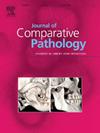英国非人类灵长类动物的内阿米巴病
IF 0.9
4区 农林科学
Q4 PATHOLOGY
引用次数: 0
摘要
内阿米巴病是非人灵长类动物(NHPs)中的一种重要疾病,可引起一系列临床表现,从无症状携带到严重的坏死性结肠炎和危及生命的肠外传播。本研究调查了2004年至2020年9个动物园收集的圈养NHPs中的内阿米巴病。通过组织病理学和溶组织内阿米巴免疫组化检测,共28例,跨越9个旧世界(OW)和4个新世界(NW)灵长类物种。内阿米巴病引起肠内和肠外疾病,包括坏死性结肠炎和肝炎,具有特征性的大体和组织学病变,包括界限清晰的跨壁“瓶状”粘膜溃疡和坏死性肝炎,并伴有病变内阿米巴滋养体。罕见病例表现为肺炎、腹膜炎和睾丸炎。OW灵长类动物,特别是Colobinae物种,更经常受到影响。本研究扩大了内阿米巴虫病的已知宿主范围,首次报道了皇绢毛猴(Saguinus imperator)、疣王猴(colobus polykamos)、灰叶猴(Presbytis comata)、黑吼叫猴(Alouatta caraya)、棕色蜘蛛(Ateles hybridus)和白面猕猴(Pithecia Pithecia)。没有观察到季节性趋势,病例涉及男女和所有年龄组,主要是成年人。物种特异性差异被注意到,OW灵长类动物有更频繁的跨壁结肠炎。这些发现强调了内阿米巴病在有胃肠道体征的NHPs鉴别诊断中的重要性,并建议在尸检时常规收集新鲜、冷冻和福尔马林固定组织,优先收集胃肠道和肝脏样本。国家卫生保健计划中对内阿米巴原虫物种的定期健康评估和监测对于发现亚临床携带者,实现早期、有针对性的干预和尽量减少对国家卫生保健计划种群和保护工作的负面影响至关重要。本文章由计算机程序翻译,如有差异,请以英文原文为准。
Entamoebiasis in zoological non-human primates in the United Kingdom
Entamoebiasis is a significant disease in non-human primates (NHPs), causing a spectrum of clinical presentations ranging from asymptomatic carriage to severe, necrotizing colitis and life-threatening extraintestinal dissemination. This study examined entamoebiasis in captive NHPs across nine zoological collections from 2004 to 2020. A total of 28 cases, spanning nine Old World (OW) and four New World (NW) primate species, were confirmed via histopathology and Entamoeba histolytica immunohistochemistry. Entamoebiasis caused intra- and extraintestinal disease, including necrotizing colitis and hepatitis, with characteristic gross and histological lesions including well-demarcated transmural ‘flask-like’ mucosal ulceration and necrotizing hepatitis with intralesional amoebic trophozoites. Rare cases presented with pneumonia, peritonitis and orchitis. OW primates, particularly Colobinae species, were more frequently affected. This study expands the known host range of entamoebiasis providing the first reports in emperor tamarin (Saguinus imperator), king colobus (Colobus polykamos), grizzled leaf (Presbytis comata), black howler (Alouatta caraya), brown spider (Ateles hybridus) and white-faced saki (Pithecia pithecia) monkeys. No seasonal trends were observed, and cases involved both sexes and all age groups, predominantly adults. Species-specific differences were noted, with OW primates having more frequent transmural colitis. These findings emphasize the importance of entamoebiasis in differential diagnoses for NHPs with gastrointestinal signs, and include recommendations for routine collection of fresh, frozen and formalin-fixed tissues during necropsy, prioritizing gastrointestinal and hepatic samples. Regular health assessments and surveillance for Entamoeba species in NHPs are crucial for detecting subclinical carriers, enabling early, targeted interventions and minimizing negative impacts on NHP populations and conservation efforts.
求助全文
通过发布文献求助,成功后即可免费获取论文全文。
去求助
来源期刊
CiteScore
1.60
自引率
0.00%
发文量
208
审稿时长
50 days
期刊介绍:
The Journal of Comparative Pathology is an International, English language, peer-reviewed journal which publishes full length articles, short papers and review articles of high scientific quality on all aspects of the pathology of the diseases of domesticated and other vertebrate animals.
Articles on human diseases are also included if they present features of special interest when viewed against the general background of vertebrate pathology.

 求助内容:
求助内容: 应助结果提醒方式:
应助结果提醒方式:


